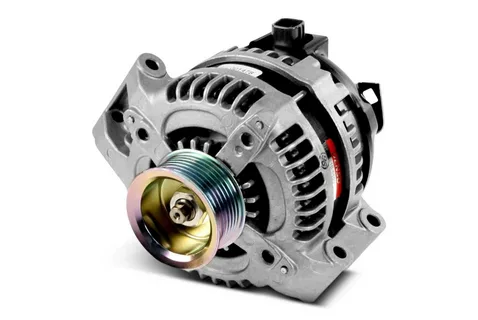Many car owners may encounter the task of replacing the alternator in a Holden Viva at some point. Ensuring that this crucial component is functioning optimally is vital for the vehicle’s overall performance and reliability. This guide provides a comprehensive checklist for Holden Viva Alternator Replacement, aiming to assist in maintaining the vehicle’s electrical systems effectively.
Signs of a Failing Alternator
Recognising the signs of a failing alternator in a Holden Viva can help prevent unexpected breakdowns and costly repairs. Dimming headlights are a standard indicator, suggesting the alternator may not provide sufficient power.
A battery warning light on the dashboard is another clear sign that the alternator is struggling to charge the battery effectively. Unusual noises like grinding or whining from the engine bay can signal alternator issues.
Additionally, malfunctioning electronic accessories, like power windows and air conditioning, might point to an alternator problem. Paying attention to these symptoms can ensure timely intervention and maintain the vehicle’s performance.
Tools and Equipment Needed
Replacing an alternator in a Holden Viva requires the right tools and equipment to ensure a safe and efficient job. A spanner set and socket set are essential for loosening and tightening bolts. A multimeter is crucial for testing electrical connections and confirming proper voltage output.
A serpentine belt tool is needed to manage the belt’s tension during removal and installation. Additionally, it is advisable to use protective gloves and safety glasses to prevent injuries. These tools will facilitate the replacement process, making it smoother and more straightforward.
Preparing the Vehicle for Replacement
Preparing the vehicle for a Alternator Replacement involves several crucial steps to ensure safety and efficiency. Begin by parking the car on a level surface and ensuring the handbrake is firmly engaged to prevent movement during the procedure.
Disconnect the negative battery cable to eliminate the risk of electrical shocks, a step essential for safety when working on the vehicle’s electrical system. Gather all the tools and equipment mentioned earlier, and keep the replacement alternator within reach for easy access.
Additionally, it is beneficial to consult the vehicle’s manual for any specific instructions or precautions related to the alternator replacement. This preparatory phase sets the stage for a smoother and more efficient replacement process.
Locating the Alternator
In the Holden Viva, the alternator is typically situated at the front of the engine bay, adjacent to the serpentine belt. Consulting the vehicle’s manual can be beneficial to pinpoint its exact location, as it provides specific details and diagrams. Often, accessing the alternator may require the removal of specific components, such as the air intake assembly or other obstructive parts.
This process ensures clear visibility and adequate working space, which is essential for the subsequent steps in the replacement procedure. Identifying the alternator’s precise position is crucial, facilitating a smoother and more efficient alternator replacement process.
Removing the Old Alternator
Begin by disconnecting the main power cable and any auxiliary connectors attached to the alternator. Ensure each connection is carefully detached to avoid damage to the wires or terminals.
Remove Mounting Bolts
Use a spanner or socket set to loosen and remove the bolts securing the alternator to the mounting bracket. It is advisable to keep these bolts affect’s, as they may be reused for installing the new alternator.
Loosen the Serpentine Belt
Utilise the Serpentine belt tool to release the tension on the belt. Carefully slide the belt off the alternator pulley, ensuring that it does not disturb its routing around other pulleys.
Extract the Alternator
Once the belt is removed, gently manoeuvre the alternator out of its position. This might require some wiggling, but avoid using excessive force that could damage surrounding components.
Inspect and Clean the Area
Before proceeding, take the time to inspect the alternator’s mounting area for any signs of dirt, debris, or damage. Clean the area thoroughly to ensure a smooth installation of the new alternator.
Organise Components
Place the old alternator and any removed components in a safe location. Keeping everything organised will aid in reassembly and prevent the misplacement of essential parts.
Inspecting the Alternator Bracket and Surrounding Components
Before installing the new alternator, a thorough inspection of the alternator bracket and the surrounding components is essential. This involves checking the bracket for any cracks, bends, or signs of corrosion that could compromise its stability and alignment. Ensuring that the mounting surfaces are clean and free from debris is also crucial, as dirt or rust can affect the proper seating of the alternator.
Additionally, examine the condition of the mounting bolts and any additional hardware, replacing any worn or damaged items to guarantee a secure installation. Inspect the electrical connectors and wiring for any signs of fraying, corrosion, or other damage. Ensuring all connections are tight and free from contaminants will help maintain a reliable electrical connection.
It is also recommended that adjacent components, such as the serpentine belt and pulleys, be checked. A worn or damaged belt can lead to improper tension and reduced performance of the new alternator. Ensuring that all surrounding components are in good working order will contribute to the overall efficiency and longevity of the replacement alternator.
Reconnecting the Battery and Testing the Installation
Reconnect the negative battery cable to restore power to the vehicle’s electrical system. Start the engine and carefully observe the alternator’s performance. Listen for unusual noises that indicate improper installation or a defective component. Monitor the dashboard for warning lights that might suggest an issue with the new alternator or the electrical system.
Using a multimeter, measure the alternator’s output voltage. When the engine is running, it should fall within the manufacturer’s specified range, typically around 13.5 to 14.5 volts. Check all electrical connections to ensure they are secure and corrosion-free, which could impact the alternator’s functionality.
Inspect the serpentine belt to confirm it is properly tensioned and routed around the pulleys. Any misalignment or incorrect tension could lead to reduced performance or further mechanical issues. Additionally, test any electrical accessories, such as headlights, power windows, and the radio, to ensure they are operating correctly, as this can confirm the alternator is providing adequate power.
Installing the New Holden Viva Alternator
Carefully lower the new Holden Viva Alternator into the engine bay, ensuring it aligns correctly with the mounting bracket. Verify that the pulley aligns with the serpentine belt to avoid alignment issues.
Secure the Alternator
Reattach the mounting bolts to secure the alternator in place. Tighten the bolts evenly to ensure the alternator is firmly attached to the engine block. Use a torque wrench if specified by the manufacturer to achieve the correct tightness.
Reconnect Electrical Connections
Attach the main power cable and any auxiliary connectors to the new alternator. Ensure each connection is secure and corrosion-free to maintain optimal electrical performance.
Reinstall the Serpentine Belt
Using the Serpentine belt tool, guide the belt back onto the alternator pulley. Check that the belt follows the correct routing and maintains proper tension to ensure efficient operation.
Reattach Additional Components
If any brackets, covers, or other components were removed during the disassembly, reinstall them now. Ensure all bolts and parts are returned to their original positions and securely fastened.
Double-Check Installation
Review all connections and fastenings to confirm that everything is correctly installed and secure. This step helps prevent potential issues once the engine is started.
Common Mistakes to Avoid During Replacement
Common mistakes during a Holden Viva Alternator Replacement can complicate the process and lead to future issues. One frequent error is cross-threading bolts, which can damage the threads and compromise the stability of the alternator.
Over-tightening the serpentine belt is another mistake, potentially causing excessive wear and strain on both the belt and alternator pulley. Disconnecting the battery before beginning the replacement can result in electrical shocks or short circuits.
Additionally, inspecting surrounding components, such as the serpentine belt, pulleys, and electrical connections, can lead to overlooked issues that might affect the performance of the new alternator. Using the wrong tools or attempting to force components into place can also cause damage and hinder the effectiveness of the repair. Taking the time to follow proper procedures and use the correct tools will help avoid these common pitfalls.
Maintenance Tips for Longevity of the New Alternator
Regular maintenance is crucial for ensuring the longevity and optimal performance of the new alternator in a Holden Viva.
- Begin by periodically inspecting the serpentine belt for signs of wear or damage, as a worn belt can adversely affect the alternator’s efficiency.
- Ensuring that the belt maintains the proper tension is also essential, as an overly tight or loose belt can lead to premature failure.
- Cleaning the alternator and its surroundings can help prevent dust and debris from causing overheating or other issues.
- Using a dry cloth or a compressed air canister, gently remove any dirt or build-up from the alternator’s surface and the engine bay.
- Additionally, regularly checking the electrical connections is vital; ensure that all terminals are clean, secure, and corrosion-free, as poor connections can disrupt the alternator’s function.
Appropriate Tools
Appropriate tools and equipment are crucial for a safe and effective replacement. Ensuring that the vehicle is adequately prepared before commencing work helps avoid potential hazards and facilitates a smoother workflow. Careful handling of components, especially when removing the old alternator and installing the new one, ensures that no damage is inflicted on surrounding parts, which could otherwise compromise the vehicle’s functionality.
Regular inspection and maintenance of the alternator and associated components are critical practices for prolonging the lifespan of the replacement alternator. Attention to detail during reassembly and thorough testing of the system’s functionality help confirm that the replacement has been successful.
Adhering to these guidelines will allow the Holden Viva’s electrical system to continue functioning efficiently, supporting the vehicle’s performance and reliability. Proper maintenance practices will also ensure that the new alternator remains in good working condition for as long as possible.
Conclusion
Conducting a Holden Viva Alternator is a meticulous process that demands attention to detail and a systematic approach. Ensuring that all steps, from initial preparation to final testing, are executed correctly significantly contributes to the vehicle’s overall performance and reliability. Correctly identifying and addressing signs of a failing alternator early on can prevent more severe issues and costly repairs down the line.
FAQs
What are the signs that the alternator needs to be replaced in a Holden Viva?
Common indicators include:
- Dimming headlights.
- A battery warning light on the dashboard.
- Unusual noises from the engine bay.
- Malfunctioning electronic accessories such as power windows and air conditioning.
What tools are necessary to replace the alternator in a Holden Viva?
Essential tools include a spanner set, socket set, multimeter, serpentine belt tool, protective gloves, and safety glasses. These tools facilitate a safe and efficient replacement process.
How long does replacing an Holden Viva Alternator typically take?
The duration can vary based on experience and familiarity with the vehicle. Generally, the process can take 1 to 3 hours, considering the time needed for preparation, removal, installation, and testing of Holden Viva Alternator.

